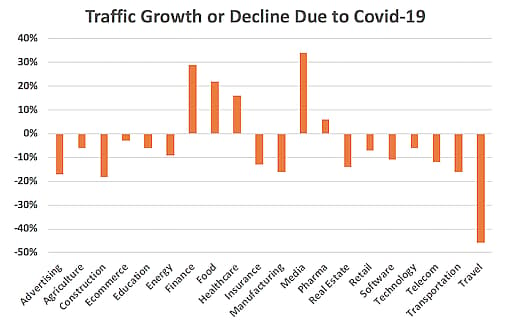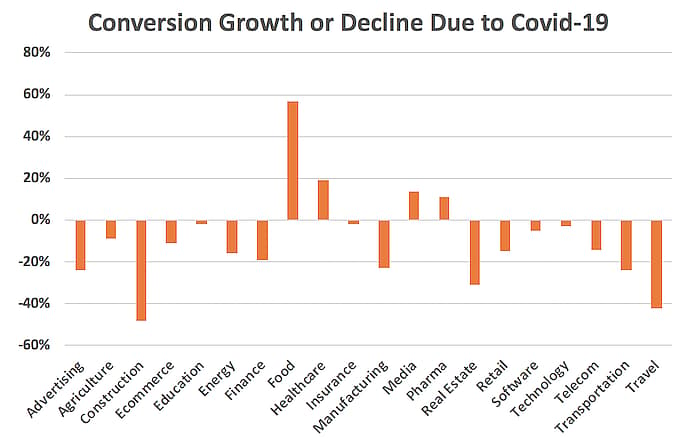How COVID-19 is affecting marketing.
The world is shutting down and every part of society as we knew it is on standby and needing to adjust in some drastic manner. Of course, the most important thing we must all consider right now is our health and the wellbeing of everyone around us.
But the shockwaves are being felt by people and organisations alike. It is estimated that the epidemic is set to cost the global economy $2.7 trillion in output alone; a disturbing figure. As such, businesses are making cutbacks; downsizing departments and limiting their spend to protect themselves from increasing their debt in such uncertain times. But that’s not always the right thing to do.
What we can be certain about, is that organisations need to consider their digital agenda now more than ever before. Businesses that are traditionally offline will need to innovate sooner rather than later to adapt to this new way of living.
In this post, we’re going to explore how COVID-19 has and will affect marketing departments and marketers individually, and what can be done to make the most of a shituation.

What marketers should not be doing.
It’s important to emphasize that Coronavirus should not be viewed as an opportunity to profit from people’s fear, but the need for marketers to adapt is necessary. The fact is, the effects are presenting marketers with new ways to retain and attract audiences with internet usage up around 50% (almost at breaking point).
This post has been created to help marketers adapt to the rapidly changing business environment and shifting customer preferences.
The situation we’re in is unprecedented. No one really knows what’s best. No one has all the answers but the chances are you will have a guy feeling over whether your marketing is right or not. Remember to lead with empathy and understanding, and you will be fine.
Let’s look at the short-term impact of COVID-19 on marketing.
Research recently published by the Drum revealed that 61% of marketers are altering their short-term media strategy and only 9% are making long-term changes.
Respondents made it clear that the immediate plan was to shift their offline marketing efforts to digital, considering offline methods will have far fewer eyes on them than usual, and the time people spend online is increasing.
In many cases, particularly within SMEs, marketing budgets will be slashed and marketers will have to come up with clever ideas to retain their audience without the budget they were expecting to be playing with at the beginning of the year.
On the other hand, larger businesses and those which see this as an opportunity to capture new audiences will be shifting their offline marketing budget to digital to try and take advantage of the sheer number of people online.
Media is currently being consumed at a higher rate than ever before. Digital display ads, social media and online video are channels that will likely increase with the short-term marketing strategy adjustments that marketers must now make.
Redistribute your marketing spend, don’t cut it.
Budgets for offline marketing methods like out of home advertising will have tiny exposure, and event marketing has come to an absolute standstill.
In a time of global crisis like this, it is natural to think that cutting non-essential business spend is the safe option, but it can be seriously damaging to the long-term prosperity of a business.
It should be a question of how to adapt, rather than which parts of normal business activity to chop.
By revising your marketing strategy and shifting offline advertising budgets to digital ad spend, not only will you retain your audience, but you will also have the opportunity to attract an entirely new audience with millions of people spending even more time on the internet.
Traffic is largely concentrated within the coronavirus ecosphere, with related terms growing by 22x since the start of March. To put that into perspective, that’s 5x more than people are searching for “Facebook” in Google.
From an SEO perspective, Neil Patel’s agency and Ubersuggest saw a huge drop in traffic across industries and around the world. Research showed what happened to the traffic of their many clients across multiple sectors. The following data has been collected from sites that gain over 5,000 monthly visitors – sites with less traffic can often experience large swings in traffic without the presence of a global issue.

Media, Finance, Food, Healthcare and Parma all experienced surges in traffic, while every other industry was hit with a decrease in traffic. This shows how important it is to consider location in your paid media strategy. Advertising via news outlets is going to deliver plenty of impressions, but the CPA might be higher than usual.
This is supported by further research conducted by Wordstream.
It’s worth mentioning that E-Commerce was a mixed bag. Essential products saw a spike in traffic, while big-ticket and luxury items saw a sharp decline. Also, what’s considered ‘essential’ is changing. Buyer preferences are changing. For example, with no gyms for people to go to, searches for dumbbells are at an all-time high.
In addition, the conversion rate for most industries was down. Even in industries where traffic spiked, like Finance, the conversion rate was lower.

Media channels saw an increase in their conversion rate as the demand for the latest news and topics went through the roof. The same is clear for online food and healthcare services.
Spend is decreasing in many sectors; travel and hospitality, offline entertainment, logistics and events are all feeling an unprecedented pressure. The travel industry, for example, is expected to lose $820bn. With flights grounded, airports and ports closed, and industry titans like Virgin asking staff to take an 8-week unpaid leave, there is no doubt that budgets are being cut left, right and centre.
However, many online services will be using this time to increase their ad spend. For example, streaming services and online news are benefiting hugely from the higher online presence. Not only is their traffic increasing, but their conversion rates are also increasing, so marketers are doubling down.
In terms of how Google search ads are performing across the board, here are some interesting facts and figures:
- Clicks are down 7% (similar to a holiday weekend)
- Conversions are down 21% on average
- CTRs are up 10%
- CPCs are down 15%
What does this tell us? Well, while conversions are down, cost-per-clicks are cheaper and more people are ending up on the site, so it’s a good time to be running some awareness campaigns for long-term brand building purposes.
It’s also worth mobile ad traffic is down 24%, so it might be worth readjusting your advertising if they’re heavily targeted toward mobile.
Display, social and video ads are all performing well and should be invested in.
So, marketers must decide whether to supplement their poor performance in search with running ads to boost traffic, or to cut their marketing spend to reduce costs and risk losing out on the opportunity to reach new customers in new ways.
However, be aware that Google may penalise ads that use the “coronavirus” or “COVID” in the ad copy as they seek to prevent people from taking advantage of the pandemic.
Moving to flexible platforms.
Marketers experiencing budget cuts should take the opportunity, while working from home, to analyse their current technology stack to ensure the tools they use are digital-first and enable remote working rather than hinder it.
Business must go on during the pandemic, so take what you can online. Use Google Drive rather than Microsoft Office, use Monday.com for managing your team’s tasks, Slack for communicating with your colleagues and consider which manual processes can be automated with a digital solution.
In addition, now is the time to move to cheaper and more flexible channels. Programmatic ads will be receiving more impressions than usual with so many people online, so it is essential to consider how the effects of COVID-19 are changing your audience’s behaviour and then adapt to meet their adjusted needs.

What to keep in mind during the pandemic.
Keep the long-term in mind. This too (touch wood), shall pass. While our natural instinct is to focus on the short-term and make sure our businesses are able to continue as best as possible, marketers must also focus on their long-term strategies. There will be new growth opportunities once things have calmed down – whenever that may be.
Brand development is an important long-term marketing strategy and cutting media spend too much when it isn’t necessary might damage your brand’s positioning when this pandemic is over.
Another thing to keep in mind is post-pandemic campaigns. These campaigns should be full of optimism and also speak to the effect that COVID-19 is likely to have had on your target market. Prepare promotions, incentives, competitions and other campaigns that inspire, rejuvenate and capture a share of sales when they begin to recover.
Do not underestimate how this has and will change your customer behaviour.
Find out where your target audience is and ideate how they have changed their lifestyle to adapt then map out how you can target them effectively with relevant messaging.
What is the emotional context? What do they want to hear? What is useful to them right now? How should you be communicating with them?
Seize the marketing opportunities.
This is the largest global health pandemic that the generations of today have ever experienced. It’s a new time for everyone. Since so many people are working from home and adjusting their lifestyles so significantly, marketers are facing new types of online behaviour.
Online activity and browsing for services could occur at times marketers aren’t used to. For example, people might find their traffic spikes at times when it’s traditionally been low, like lunchtime.
Paid media could become cheaper as marketing budgets in certain industries are cut. If there is a possibility of increasing your share of voice in an industry which is largely reducing media spend, it could have a great impact on your long-term marketing success.
With many industries and businesses reducing their marketing budgets, we will probably experience a drop in CPM (cost per mile) and CPC (cost per click) prices due to the lower levels of competition.
This presents an opportunity for some marketers to acquire new customers at a lower cost than before. With so many people glued to the latest news, securing ad space on news websites and apps could be cheaper and capture more eyes than prior to the outbreak.
Interestingly, Neil Patel’s research (cited above) suggests that there has been a slight drop in cost per click price but a sharp increase in cost per acquisition.
Conclusion.
Without a doubt, the Coronavirus has left its mark in the history books. The question marketers should be asking themselves is just how much will this change things? We are starting to realise the impact the virus has had on industries, but how will the innovative marketers of today adjust? One thing is certain – digital solutions should be at the top of the agenda for all businesses.
We’re currently offering free marketing consultations to help overstretched marketing teams with their campaigns. Drop us a line if you need a hand.
Subscribe to our weekly Marketing through COVID-19 newsletter if you want some extra support during isolation.
We’ll be releasing weekly content resources to help marketers navigate through the pandemic.

